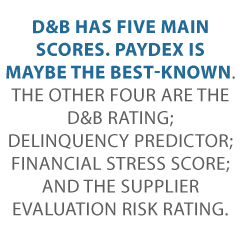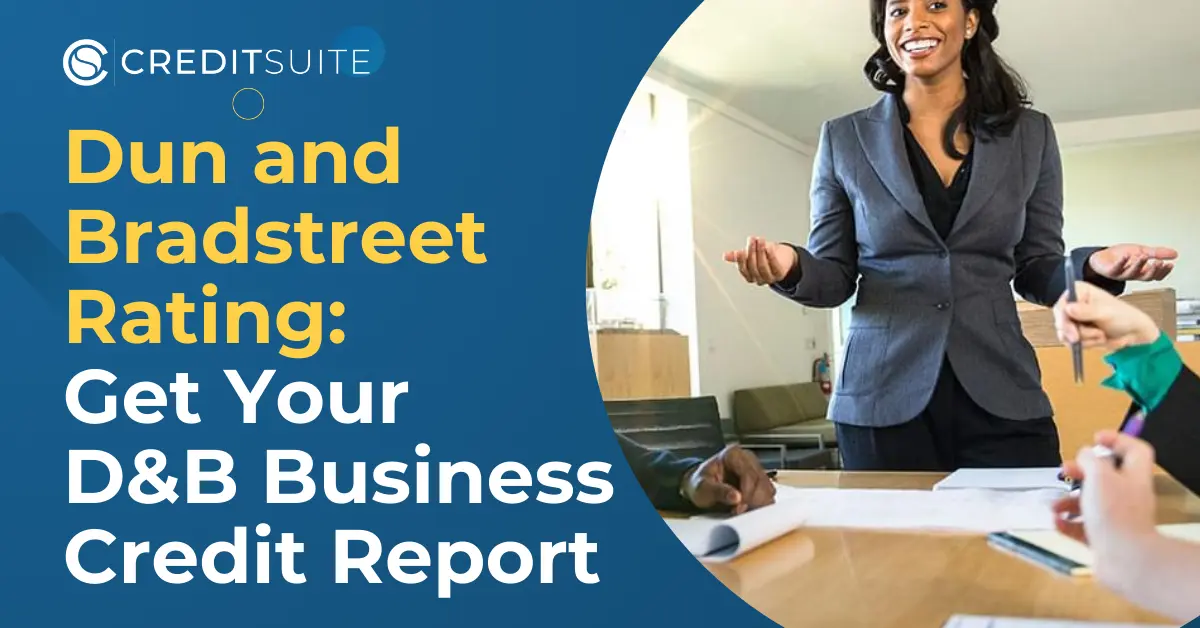This blog may contain affiliate links that might result in Credit Suite receiving a commission if you use them. This has no impact on the price you are charged for the product or service.
Do you want to know all about the Dun and Bradstreet Rating and all of their scores and reports? D&B is the oldest and largest credit reporting agency. But you will need a D-U-N-S number to start building business credit. What if you don’t have a D-U-N-S number? Then get one; they are free. So this number gets a business into their system.
What are D&B Reports All About?
 To consider the scores, you need to look at D&B Reports. D&B offers database-generated reports. The business services giant produces such a report in order to help their clients decide whether a business is a good credit risk. Companies use the reports to make informed business credit decisions and avoid bad debt. So several factors enter into creating such a report.
To consider the scores, you need to look at D&B Reports. D&B offers database-generated reports. The business services giant produces such a report in order to help their clients decide whether a business is a good credit risk. Companies use the reports to make informed business credit decisions and avoid bad debt. So several factors enter into creating such a report.
In general when D&B does not have all of the data they need, they will indicate as much in their reports. But missing data does not necessarily mean a company is a poor credit risk. Instead, the risk is unknown.
This is true for the Dun and Bradstreet Rating and for any other D&B business credit score.
The main reason for a client using this kind of a report is to engage in credit risk monitoring of merchants, suppliers, and business partners. This helps companies make informed business credit determinations and steer clear of bad debt.
Dun & Bradstreet takes many factors into account in producing such a report. These include a predictor of payment delinquency; how financially stressed a company is compared to comparable businesses; an evaluation of supplier risk; credit limit recommendation; D&B rating; and PAYDEX score. So let’s consider all of these factors in turn.
Is D&B Data at All Accurate?
D&B Data is only as good as how complete it is. D&B constantly gathers data. So it works to improve its analyses to assure the greatest degree of accuracy possible. To ensure as accurate a report as possible, give D&B your company’s current financial statements.
What are Dun & Bradstreet Scores All About?
Now let’s look at Dun & Bradstreet Scores. D&B has five main scores. PAYDEX is maybe the best-known. The other four are the D&B Rating; Delinquency Predictor; Financial Stress Score; and the Supplier Evaluation Risk Rating. For a sample Business Information Report, go to products.dandb.com/download/2019_BIR-Snapshot-Report.pdf.
So the main score is PAYDEX. However, a business will not get a PAYDEX score, unless it has at least 3 trade lines reporting, and a D-U-N-S number. A business must have BOTH to get a D&B score or report.
What is the PAYDEX Score?
Let’s focus on the PAYDEX Score. This is Dun & Bradstreet’s dollar-weighted numerical rating of how a company has paid the bills over the past year. D&B bases this score on trade experiences reported by various vendors. The Score ranges from 1 to 100; higher scores mean a better payment performance. PAYDEX scores reflect how well a company pays its bills. Larger bills get more weight in the calculation.
What is the Dun and Bradstreet Rating?
Now let’s check out the Dun and Bradstreet Rating. Dun & Bradstreet bases the Dun and Bradstreet Rating on a company’s net worth based on financial statements, as well as the company’s overall condition.
So a Dun and Bradstreet Rating is meant to help businesses rapidly gauge a business’s size and composite credit appraisal. The Dun and Bradstreet Rating is based on information in a company’s interim or fiscal balance sheet, and also an overall evaluation of the firm’s creditworthiness.
If a company’s financial statements are not provided, the score is based on company size, industry, or other related factors. If a company does not provide info, D&B will base certain scores on other related information in their file.
A company will get a lower Dun and Bradstreet Rating if they do not provide any information. It is in every company’s best interests to provide as much info to Dun and Bradstreet as possible.
What is the D&B Delinquency Predictor?
So let’s consider the Delinquency Predictor. The Delinquency Predictor runs from 1 to 100. Higher scores are better. Dun & Bradstreet uses predictive models to determine how likely a company is to be late with its payments. Predictive scoring is a method of using historical information in order to try to predict future outcomes. It entails identifying the risks inherent in a future decision. It does this by examining the relationship between historical information and the future event.
This represents an objective and statistically derived counterpart to subjective and intuitive assessments. Such scoring allows a business to rank and order accounts based upon the probability of an event taking place, such as delinquent payments.
That being said, note that predictive scoring only represents a statistical probability. So it is not a guarantee. The scoring system ranks and orders accounts based on the probability of late payments. However, a new company has no historical information, by definition.
The Delinquency Predictor looks at the proportion of slow payments in recent months; Proportion of past due balances to total amount owing; the higher risk industry based on delinquency rates for this industry; any increase in proportion of delinquent payments in recent payment experiences; and any evidence of open suits.
What is the Dun & Bradstreet Financial Stress Percentile?
Now let’s tackle the Financial Stress Percentile. The percentile runs from 1 to 100. 1 percentile is most likely to fail. The 100 percentile is least likely to fail. It is a comparison to other businesses.
The Financial Stress Percentile compares the company in question to other businesses in the same location, business sector, number of employees, or number of years in the business. Financial Stress Score Norms show an average score and percentile for all firms with similar demographic characteristics. These Norms can be used in order to benchmark where this particular business stands in relation to the norm for its peer group.
It is based on a much higher raw score, the Financial Stress Score. The Financial Stress Score runs from 1,001 to 1,875. A score of 1,001 represents the highest probability of business failure. So a figure of 1 shows the lowest probability of business failure.
How Does the Financial Stress Score Relate to the Financial Stress Percentile?
The Financial Stress Score is based on a low proportion of satisfactory payment experiences to total payment experiences, a high proportion of past due balances to total amount owing, any UCC Filings reported, and a high number of enquiries to D&B over last 12 months. So this score compares a company to similar businesses in the D&B database.
Dun & Bradstreet produces Financial Stress Scores to forecast the chance of business failure over the upcoming twelve months.
D&B defines business failure in several ways. One is as a business which gets legal relief from its creditors. Another is a firm which discontinues its business operations without paying off all of its creditors in full. Yet another is a business which voluntarily withdraws from its business operations thereby leaving unpaid obligations
Another way is a company which enters into receivership or reorganization. Or it can be a company which makes some kind of arrangement for the benefit of its creditors. And all of this is based on the information found inside D&B’s commercial database.
If your company has a lot of lawsuits and liens against it, those will negatively impact your financial stress score.
What is the Dun and Bradstreet Supplier Evaluation Risk Rating?
How about the Supplier Evaluation Risk (SER) Rating? So this is a scale of 1 to 9. 1 means a company is least likely to fail to pay its own suppliers. Whereas 9 is the opposite, showing highest likelihood.
The Supplier Evaluation Risk Rating forecasts how probable it is that a company will get legal relief from its creditors. Or it can show the chance a business will discontinue its operations without paying creditors in full over next twelve months. The SER rating comes from D&B’s Financial Stress Score. So the Financial Stress Score percentile serves as the basis for the SER Rating.
Factors affecting a Supplier Evaluation Risk Rating are a negative net worth, and the proportion of slow payment experiences to total number of payment experiences reported. So the factors also include if a business belongs to an industry with above average risk of ceasing operations or becoming inactive.
So it is not exactly the same as the Dun and Bradstreet Rating.
https://creditsuite.wistia.com/medias/0gi219yz29?embedType=async&videoFoam=true&videoWidth=640
What is the D&B Maximum Credit Recommendation?
Consider the Maximum Credit Recommendation. So it includes recommended dollar guidelines. D&B performs an overall assessment of a business for the next 12 months. They also check the predicted risk of business discontinuation. Further, they look at the predicted risk of severely delinquent payments.
D&B bases its dollar guideline amounts on a historical analysis of overall business risk. A recommended limit is based on the probability of severe delinquency. But this recommendation is no guarantee that a business can cover the recommended amount.
More Information about D&B Business Information Reports
What else is in D&B Business Information Reports? In addition to the above scores, a D&B Business Information Report contains trade payments (summary and by industry). So it also has trade line specifics with dollar amounts and terms, and legal events. It also has company events (mainly concerning ownership and management). So it also has a company family tree showing ownership specifics.
A Business Information Report also contains a Risk Assessment summary. So this summary shows the Maximum credit recommendation; PAYDEX; Delinquency Predictor percentile; Financial Stress percentile; and the Supplier Evaluation risk.
Dun and Bradstreet Rating: Takeaways
Dun & Bradstreet collects objective data points on businesses and creates Business Information Reports from them. These reports outline five basic scores. So some of these are predictive scores. The more information D&B has, the more comprehensive the report is.
Finally, a Dun and Bradstreet Rating is only as good the information in its report.
Dun & Bradstreet’s database includes over millions of firms spanning the globe. So this includes millions of active companies and millions more companies which are out of business but kept for historical reasons.
D&B constantly gathers data and works to improve its analyses to ensure the greatest degree of accuracy possible. To ensure as accurate a report as possible, it quite literally pays to provide D & B with your business’s current financial statements. In that way, you will have a far more accurate Dun and Bradstreet Rating sand D & B report.
Because an accurate D&B report means you are far more likely to get business funding.

